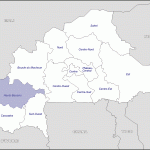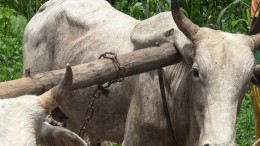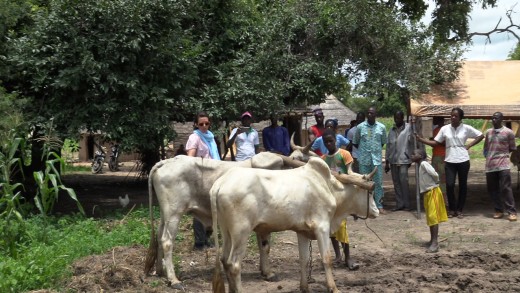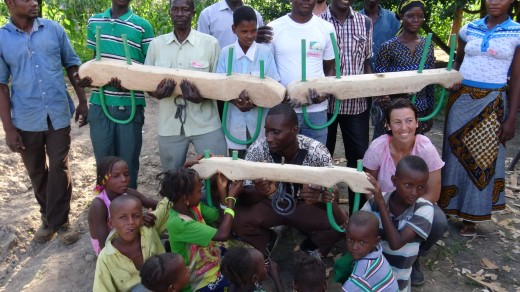
Ninety-two percent of the population of Burkina Faso is involved in agricultural pursuits (Beal et al., 2015). Agricultural production is labor intensive for smallholder farmers. Small landholders typically work less than 3.5 hectares, while mid-size farms are about 7 hectares and large farms are typically 10 hectares or larger. The rural population relies on subsistence farming, and nearly the entire rural population lives in poverty. Forty-five percent of the farms have an income of less than $1 per day. The Appropriate Scale Mechanization Consortium (ASMC) has partnered with the Polytechnic University of Bobo-Dioulasso to improve management practices and technologies for maize cultivation in the Hauts-Bassins region of Burkina Faso. The main cash crops in this region are maize, cotton, soybeans, peanuts and sesame. The mechanization practices developed for maize will be applicable and transferable to these other cash crops. These ASMC efforts will provide the smallholder farmers with improved agricultural techniques and technologies that will sustainably increase agricultural production, reduce labor and drudgery, increase socio-economic status, and improve the overall quality of life.
Transition to improved mechanization technologies in Burkina Faso
Agricultural mechanization remains extremely low in Burkina Faso.
Approximately 70 percent of the farmers do all their field work by hand. Twenty-nine percent of the farmers use animal power and are considered to be privileged farmers by having oxen as a power source. Only about 1 percent of farmers use mechanized power units, and in many cases, they are used solely for plowing while the other labor-intensive work of seeding, weeding, crop care and harvest is being done by hand. In this situation, advancing animal power is seen as the most appropriate technology for cropping system intensification of smallholder farms in Burkina Faso.
Figure 2. Low-stress training techniques will make the animals more productive and able to do a better job of planting and weeding.
In the development of U.S. agriculture, mechanization and technological change progressed in the context of scarce labor and plentiful land (Cochrane, 1993). The transition from animal power to agricultural machinery allowed producers to improve the timeliness of field operations and increase the area of land under agricultural production. Investments in farm machinery steadily increased as the yields and profitability of farming increased due to these new mechanized technologies. The new machines allowed farmers to save time and labor, which allowed them to produce a greater volume of crops on a larger area of land. The labor-saving machines that were developed as U.S. farms grew in size, “were typically built by local blacksmiths who lived among farm people, understood their needs, repaired their hand tools, and loved to tinker with tools, equipment, and machines,” (Cochrane, 1993). The conditions that supported the transition from animal power to engine power in the U.S. do not currently exist in Burkina Faso. Labor is adequate currently but becoming scarce as more people migrate to urban areas and as more children are attending school. Farmland for expansion is rare because land is a valuable family asset that Burkinabe farmers are reluctant to sell.
Animal traction as an appropriate technology
The availability of donkeys and cattle, small and constrained land base, low farm income and the great expense of modern power units are among the reasons why animal traction is the most appropriate technology for the majority of farmers in Burkina Faso. Very few farmers can use wheeled tractors profitably. An analysis of engine power versus animal power is not simply an economic question when assessing appropriate technologies. Traditional machinery economics typically relies on partial budgeting techniques bounded by ownership and operating costs and most often fails to capture many ancillary benefits and risk mitigation factors associated with animal power. Animal power is appropriate because:
- The expense of modern machinery is a barrier for subsistence farmers. Cattle (9 million head) are plentiful (Beal et al., 2015), readily available, and they reproduce so oxen can be replaced with little capital outlay.
- Machines depreciate in value as they age. Oxen appreciate in value as they grow and mature so farmers can sell them for more than they bought them for. Value is added to young draft animals in the training they receive.
- Modern farm equipment requires significant repair and maintenance costs (2015 Farm Machinery Cost Estimates Lazarus, 2015). Reliance on mechanized power increases risk because the farming communities lack the skills and support infrastructure to quickly repair breakdowns and assure timely field operations. Oxen are readily available and can be easily replaced if they become disabled.
- Fuel is expensive and subject to unpredictable swings in cost. This increases the risk of machine ownership. Draft animals need to be fed, but value is added as they mature and gain weight. The sale of mature cattle mitigates risk because it is an important source of farm income each year.
- In many areas, roads are poor and wheeled vehicle access is difficult and at times impossible. Draft animals can navigate narrow trails and rugged terrain even in adverse weather.
- Wheeled tractors can damage the soil in poor field conditions. Draft animals are less damaging to wet soil than wheeled tractors.
- Livestock-based cropping systems can improve soil fertility and crop yield by cycling nutrients from manure, compost, and cover crops.
Advancing Animal Power in Burkina Faso

A common assumption is that because farmers use animal power, they are undoubtedly skilled in the application of animal power. Skilled application of animal power means that the animals are responsive under the control of a single handler and responsive for demanding tasks such as planting and weeding. It means that the animals are well integrated in the farming system and used efficiently and effectively for a wide range of transport and field operations from hauling water and supplies to plowing, planting, weeding and harvesting. Well trained oxen are capable of a much higher level of work than is currently asked of them for such tasks as planting and weeding. There is a need, and there are many opportunities, to advance the skilled application of animal power in Burkina Faso.
The ASMC is working with local Burkinabe farmers to develop the skills and knowledge necessary for the improved application of animal power. In September 2016, members of the ASMC and Tillers International traveled to Burkina Faso and held workshops on improved animal yoke design and animal handling techniques in Koumbia, Burkina Faso. More information on this training can be found in the following links: Animal Handling Training Article, Animal Handling Training Video.
Figure 4. Proud Burkinabe farmers with their new ox yokes.
The livestock sector makes a significant contribution to economic growth and food security in Burkina Faso. There is a need for training and capacity building in all aspects of animal traction including cattle selection, training, feeding, health and animal comfort. Similar efforts are also needed in building, repairing and maintaining simple, low-cost tools for animal traction. Advancing animal traction will be a cornerstone in advancing mechanization for sustainable intensification of cropping systems in Burkina Faso.
Authors
Tim Harrigan, Associate Professor, Biosystems and Agricultural Engineering, Michigan State University;
Vinsoun Millogo, Assistant Professor, Université Polytechnique de Bobo-Dioulasso
Robert Burdick, Tillers International, Scotts
References
Beal, T., C. Belden, R. Hijmans, A. Mandel, M. Norton and J. Riggio. 2015. Country Profiles: Burkina Faso. Sustainable Intensification Innovation Lab. Link to the SIIL Country Profile Site
Cochrane, W.W. 1993. The Development of American Agriculture: A Historical Analysis. 2nd Edition. University of Minnesota Press, Minneapolis, MN. 55455-3092.
Lazarus, W.F. 2015. Machinery Cost Estimates. University of Minnesota Extension. Link to the Machinery Cost Estimates Bulletin




